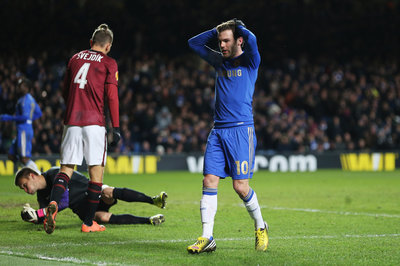
Juan Mata has been very, very good for Chelsea. In a season of inconsistent performances, he's been a clear standout, pushing for not only for the Chelsea but also the Premier League Player of the Year award with a string of assured appearances that have gone a long way to propelling Chelsea to their current position.
That's despite being shuffled around the Chelsea tactics board, initially under Roberto Di Matteo, who moved him inside from the left to a central position at the tail end of last season, only to move him wide again to the right flank to accommodate Chelsea's influx of creativity that summer.
But Mata relished in his right-wing deployment, becoming a menacing force when cutting inside onto his preferred left foot, while his narrowness also opened up room for Branislav Ivanovic to storm forward. It was, offensively speaking, a good solution to Chelsea's sudden horde of exciting young talent.
The downside of this was that, as was so well documented, it left Chelsea's flanks - specifically, the fullbacks - horrifically exposed. The best example of this was the home fixture against Manchester United, where Antonio Valencia's rampaging runs down the right flank encapsulated Sir Alex Ferguson's deliberate strategy of overloading Chelsea in wide areas. Very quickly, this became the default tactic to adopt for opposition sides, and this, along with other factors, led to a downturn in form. And as we all know, that lead to the end of the Di Matteo era.
Rafa Benitez's solution was to drill into his players some defensive awareness, instructing them to drop back into two very deep banks of four and maintaining that shape at all times when out of possession. It was a perfectly reasonable and mildly successful solution, and it's been that keenness to keep the 4-2-3-1, and the defensive structure that comes with it, that has seen Victor Moses become a prominent starter and Oscar relegated to either a bench role, or wide role.
That's because Benitez is willing to keep the wonderfully talented Brazilian away from the centre in favour of Mata's class - again, a reasonable decision - and he probably feels Oscar's work ethic is better server on the flank anyway.
That's a shame, because it robs the fans of seeing a supreme talent in what is clearly his best position, but also because it's created another tactical problem for Chelsea.
It's really quite simple. Benitez obviously wants to give his fullbacks decent protection, and the line of thought that says Mata is the weakest defensively and this should be used centrally ignores the fact that attacks can also be built through the centre.
And even though there's the protection of two deep-lying pivot midfielders, it's not always enough. The issue is exaggerated by the fact that Benitez instructs his midfielders to sit very deep, meaning there's more distance and more open space for opposition midfielders. The Chelsea duo generally has to move higher up the pitch to close the down, especially with Mata offering little defensively.
By contrast, Oscar is a solid tackler and is extremely intelligent with his marking, and impotent performances from Andrea Pirlo and Mikel Arteta are testament to this. His presence in centre attacking midfield gives the side a more balanced, cohesive feel - especially as his tenacity and awareness of space means Hazard and Mata are free to drift inside, safer in the knowledge that Oscar can move across to cover.
But this is the exact strategy that Roberto Di Matteo persisted with throughout his tenure. What makes it a solution now?
The crucial difference is that the Italian's tactics were far more fluid, more expressive, and about pressing higher up the pitch. It lead to some wildly entertaining fixtures, but a more structured approach is probably required, with the three playmakers keeping more disciplined positions. Under Di Matteo, the lack of fixed positions meant that it wasn't so much the playmakers weren't working hard enough to protect their fullback, but because the system wasn't designed for them to do that.
The line of thought then suggests that Mata would be a weakness on the right. It can be too easy to pigeonhole players into stereotypes. If you consider the actual, tangible contribution that Hazard makes defensively on the left, it's not much. How many times can you remember him making a tackle, or a crucial interception?
In many ways, a good defensive shape works simply because it exists: often, a team will be very good at defending without actually ever really defending, because they have force through numbers and an even distribution of players across the pitch, ensuring no zone can be overloaded. Mata is smart and disciplined enough to track back, and it's easy to forget his contribution in games against Manchester City (home) and Barcelona last season.
If Chelsea are going to persist with this negative, conservative approach, they can't continue to allow opponents to have an easy passing option through the centre.
(Of course, there are far more valid explanations for Chelsea's current malaise - including the weakness of Ramires as a pivot midfielder, the overall strategy and the unbalanced squad - but for the sake of this piece, we'll just focus on Mata)
Benitez's use of Mata centrally against Manchester City left Frank Lampard and John Obi Mikel covering acres of space between themselves and the City trio of Yaya Toure, Jack Rodwell and Javi Garcia, as Graham explained earlier this week. Mata stayed reasonably high up but his presence alone wasn't enough to combat the easy, sideways distribution of the City midfielders. That meant Lampard or Mikel could be drawn higher up, thus opening up space for David Silva to exploit.
Of course, there will be times when Mata used centrally either by design or by necessity, but such a strategy against stronger teams has delicate but crucial weaknesses.
~We Ain't Got No History - All Posts~Read more... Mata's central deployment is hurting Chelsea
No comments:
Post a Comment